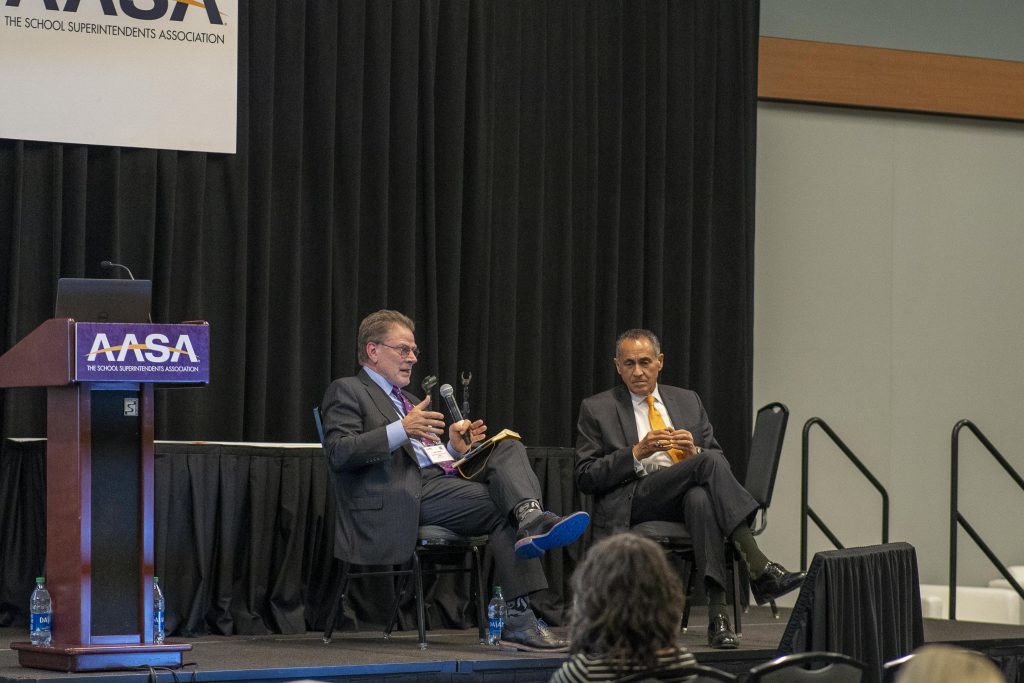Membership loss in the National School Boards Association could end up undermining the ability of AASA to effectively advocate for public education at the federal level, AASA Executive Director Daniel Domenech said Friday in an AASA national conference session with John Heim, NSBA’s new executive director and CEO.
Historically, NSBA and AASA have agreed on most legislative and policy positions and presented lawmakers with a unified message from the organizations representing school management and governance, Domenech said. Voicing fear that NSBA may splinter into two associations, he said that possibility would make it harder to present a united front to lawmakers in Washington, D.C.
The executive directors of the two organizations annually hold a joint session at each organization’s national conference. This year’s session had more discussion of political intrigue than usual.
Heim, who joined NSBA as executive director in November after leading the Kansas Association of School Boards, said he is trying to rebuild NSBA after it sent, then rescinded, a letter to President Biden seeking federal assistance to “stop threats and acts of violence” against school board members and school personnel during protests over COVID-19 mitigation efforts in schools.
Heim said there are unresolved questions about the Sept. 29, 2021, letter. Those include allegations that either the White House or the Justice Department had a role in determining the contents of the letter. Some critics have claimed the letter was intended to intimidate parents and suppress their right to express opinions to elected officials.
Noting he was hired almost two months after the letter was sent, Heim said it was “clearly a mistake.” What is not clear, he said, is what specific missteps were made. He said NSBA has hired a law firm to investigate what happened, and a report is expected at the end of March, prior to the organization’s national conference in San Diego in April. That report will enable NSBA to move forward constructively, he said.
The first thing to understand is that NSBA not a membership organization like AASA but a federation of state school boards associations, Domenech said.
While individual superintendents are members of AASA, individual school board members are not members of NSBA, he and Heim noted. Rather, a given school board can, as an entity, join a state school boards association. NSBA is a federation whose members are the state school boards associations. The maximum number of members is 49 because Hawaii does not have a state school boards association.
About 10 state school boards associations have dropped membership in NSBA in recent months, Heim indicated. Another 10 have put NSBA on notice they are reevaluating their membership status.
Domenech expressed curiosity about whether this scale of exodus could be attributed to one high-profile letter. “Being on the outside and looking at it … what else was going on?” he asked.
Heim said executive directors of state associations want more say in NSBA. Currently, the NSBA board of directors is made up solely of school board members, with one state executive director serving as a non-voting member.
Heim said he was “minding his own business” as Kansas’ executive director when fallout over the letter to Biden led to a leadership vacancy with the national association. Saying he believes the national group has a vital role, he said his goals are to reestablish trust, keep members in the fold and possibly win members back.
Domenech, he said, was the first in the nation’s capital to reach out to him after he joined NSBA. “It was so good to feel like I had a friend in Washington.”
At both the national and local levels, everything is better when school boards and superintendents operate as a team, Domenech said. If a school district has a long-term superintendent and a school board with members who have served from many years, there is a 90 percent chance that it’s a high-performing school district, he said.
“It’s so hard for a board to be successful without a good superintendent, and vice versa,” Heim agreed.
He added that the current environment seems to be tough for everyone in school leadership.
Noting he used to be a superintendent, Heim added, “I’ve closed school buildings. I’ve fired coaches. And I have never seen anything like the last two years.”
(Eric Randall is senior editor with AASA’s Conference Daily Online and editor of On Board at the New York State School Boards Association in Latham, N.Y.)

